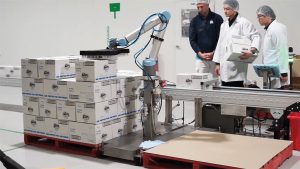Universal Robots and partner, The Robot People, discuss the benefits of collaborative robots amongst SMEs in Australia.

‘So Soft Palletiser’ at Ferndale Confectionery. See video here.
While the world’s first industrial robot was brought to life in 1962, the world’s first collaborative robot (cobot) made its way onto the scene in 2008. As the name suggests, a cobot is a robot that is intended for direct human-robot interaction within a shared space. These robots are designed specifically to work collaboratively with people.
With more than three decades experience in the industry, it is fair to say that Australian-based robotic automation specialist The Robot People has seen it all when it comes to robotic technologies.
The Robot People understands the importance of ensuring that operations produce the highest quality products at the lowest possible cost. Its team of highly experienced, process automation professionals utilise the latest robotic technologies from Universal Robots.
The Robot People Managing Director Matthew Tisdale says that despite its rapid uptake in recent years, the key benefits of cobots remain an untapped secret to many.
“You can’t beat the fast deployment, small footprint and high safety aspect of a cobot,” he says.
Speaking to the strength of their partnership with The Robot People in Australia, Universal Robots Asia-Pacific Regional Director James McKew says: “No one company’s automation requirements are the same and that is why having the skills of our valued partner, The Robot People on board is a great asset to our brand. They are helping to make cobot technologies accessible to companies both big and small.”
Myth busting: SMEs are too small to automate
Mr Tisdale believes that the barrier for deployment by Australian SME’s companies is still largely based around misconceptions.
“Some of the businesses that we encounter believe that robotic automation is only for large multinationals, and that it is simply too costly and complex to implement. However, this is the furthest thing from the truth,” he says.
He argues that cobots should be first prize for SMEs looking to automate.
Asked what an ideal candidate for cobot automation would look like, Mr Tisdale comments: “They are usually SMEs that are looking for ways to remain cost competitive whilst keeping their labour footprint low. In many cases, they have struggled to find reliable labour, need to increase their productivity, output and quality but may be lacking the time, skill or in-house resources to achieve this.”
With the changing of the supply chain and the ‘new normal’ that we find ourselves in, uncertainty about what is next abounds.
“For SMEs, the uncertainty is foremost in their mind,” says Mr Tisdale. “They look to automation to give them the low-cost base and the flexibility that they need to be ‘future adaptable’.”
Problem solving is what The Robot People does best.
“Our vast manufacturing experience enables us to design, build and implement sensible automation solutions that deliver the best possible value to our clients. We ensure that not only does the system exceed their expectations, but we also ensure that their staff are adequately trained on how to manage the application and provide ongoing support,” says Mr Tisdale .
Another issue that SMEs grapple with is that of overtime.
“Australia’s SME manufacturers typically operate during ‘daylight’ hours. During the night, assets sit idle as resourcing with reliable staff can be difficult , particularly when the requirement to extend hours are intermittent,” says Mr Tisdale.
This is where cobots come into their own. They offer reliable productivity around the clock 365 days of the year without the need for overtime pay or supervision.
Myth busting: cobots will take our jobs
Mr Tisdale says that this is simply not true.
“Employ good people and pay them well; leave the dull and dangerous jobs to cobots and free people up to do more valuable tasks elsewhere in the business. Some of our best projects have been for companies who initially ran one shift and now, with cobots assisting the workforce, they can deploy their existing staff to extend their operation. This provides a huge increase in output and significant/unit reduction in cost. The value associated with the increase in output is immense; upscaling from one shift to two makes commercial sense and can make a massive difference to the competitive position an SME manufacturer,” he says.
Mr McKew seconds this notion.
“In our years of business, cobots have been used in companies both big and small to increase productivity and improve efficiencies – not to take away jobs,” he says.
Where is the demand among SMEs?
“There has been a keen uptake in palletising applications,” says Mr Tisdale. “Palletisers can work around people and offer a safe, simple and lean solution to the manual repetition of lifting and moving heavy cartons.”
Recently, The Robot People assisted Ferndale Confectionary with an end of line solution for a palletising application.
Ferndale Confectionary General Manager Leigh Edward explains: “We produce around 12 tonnes of marshmallow per day in various packaging options from 100 to 800 grams. By manually palletising our team was packing around 7500 cartons per day – that’s 37,500 cartons per week.”
Naturally, this repetitive motion was taking its toll on Ferndale Confectionary’s employees.
“We were essentially employing people to stack boxes and as a result, we looked to cobots to help automate this rigorous and monotonous process,” says Mr Edward.
The Robot People recommended a UR10 cobot (with a 10kg payload) for the job. Pallets can be packed in many different configurations based on the varying shapes and sizes of the cartons. This cobot packs each pallet perfectly – every time.
Mr Edwards also says that they have noticed an increase in precision and quality while avoiding the risks associated with repetitive strain injuries. Employees were initially hesitant about their new co-worker, so Ferndale Confectionary decided to ‘break the ice’ with a naming competition. Fondly dubbed ‘Kerry Packer’, this cobot is now part of the family.
“Our employees are happy that ‘Kerry Packer’ has taken over the heavy-duty task and this has allowed them to move onto more meaningful tasks,” says Mr Edwards. “‘Kerry Packer’ works without any breaks or days off which is the one of the greatest benefits of deployment.”
The Robot People initially programmed the cobot and provided on-site training.
“‘Kerry Packer’ has not skipped a box for the best part of its 18-month production life with the company. As we expand our business, we will continue to use cobots for palletising and in other applications – it just makes sense.”
On cost of purchase vs payback, Mr Edward reports that Ferndale Confectionery achieved its return on investment (ROI) in less than one year.
“The real win, however, is when you figure out that you have removed 37,500 repetitive movements a week and with it the OHS compensation discussion you may have had,” he says.
Mr McKew adds: “For palletising applications, we recommend the newly launched UR10e increased payload to 12.5kg and a reach of 1300mm. This provides further options for clients considering cobots for palletising applications.”
Safety first
Adding to the uptake of cobots is the safety element.
“Cobots can work safely alongside humans – without the need for a cage, subject to prior risk assessment. They can also operate independently if needed,” says Mr McKew.
Mr Tisdale underpins this: “I can’t tell you how many times I have demonstrated the safety of a cobot by walking into its area while it is working. The safety sensors on a cobot are highly effective. You simply can’t do that with a traditional industrial robot. The effect that it has on maintaining easy access in such a small footprint shouldn’t be overlooked.”
For those looking to deploy a cobot installation, Mr Tisdale says that the lead time is between six to eight weeks (compared to typically more than 20 weeks for an industrial robot).
“This type of lead time is attractive to SMEs in their quest to become more competitive. Once customers realise how easy it is – they want to install more and that’s the beauty of cobots – they’re flexible and can grow with the changing demands of a business” he says.
According to Mr Tisdale, the ease of redeployment is yet to be properly realised.
“Just recently, we changed a carton erector application to a palletiser. When you invest in cobots you are investing in technology that can be easily redeployed to ensure that your products and processes are competitive,” he says.
Mr McKew says that the passion exuded by Mr Tisdale and his team is unmatched.
“The Robot People are professional, knowledgeable and passionate about our technologies and the positive impact they can have in ensuring the competitiveness of Australian manufacturing. It’s easy to get excited about cobots when you start talking to them – and that’s exactly what we want from our partners,” he says.
About Universal Robots
Universal Robots (UR) was founded in 2005 to make robot technology accessible to all by developing small, user-friendly, reasonably priced, flexible collaborative robots (cobots) that are safe to work side-by-side with people. Since the first cobot was launched in 2008, the company has experienced considerable growth with the user-friendly cobots now sold worldwide. The company, which is a part of Teradyne Inc., is headquartered in Odense, Denmark, and has regional offices in the United States, Germany, France, Spain, Italy, UK, Czech Republic, Poland, Hungary, Romania, Russia, Turkey, China, India, Singapore, Japan, South Korea, Taiwan and Mexico. In 2020, Universal Robots had revenue of USD 219 million.
For more information, visit universal-robots.com.





